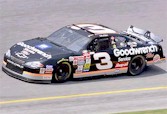 Earnhardt News Earnhardt News
2000 Season
At Daytona, horsepower vs. aero debate continues
Dave Rodman - NOL
|

Dale Earnhardt on the track at
Daytona during the aero test.
|
|
|
DAYTONA BEACH, Fla.
(August 15, 2000)
After about 6 1/2 hours of testing Tuesday at Daytona
International Speedway, a brain trust comprised of NASCAR officials, team owners, crew
chiefs, engineers and drivers will assemble their thoughts and hard data and determine a
future course of action at the NASCAR Winston Cup Series' "restrictor plate
tracks."
The test, dubbed by NASCAR a study on the relationship
of aerodynamics and engine horsepower, began at 9 a.m. and, except for a lunch break and
two "debriefing" sessions led by NASCAR Winston Cup Director Gary Nelson,
continued unabated up until about 5 p.m.
NASCAR officials and the 11 invited teams, which included
some of the series' top performers in NASCAR 2000, experimented with a variety of
aerodynamic modifications in conjunction with a variety of restrictor plate sizes in an
attempt to "balance horsepower and aerodynamic drag," Nelson said.
"It's been a neat thing to get these guys together to
work on a common cause for a change," said Mike Helton, senior vice president and
chief operating officer, NASCAR. "They've all got some good ideas and all of them
have chipped in to try and make some headway. We're feeling pretty confident that we'll be
able to come up with some rules and regulations as it relates to the aerodynamics of a car
that gives the restrictor plate races some of the old feel of racing that the competitors
and the fans are used to at Daytona and Talladega.
"As you can imagine, the feedback differs a little bit
from everyone, as the length of times that guys have been competing on these particular
race tracks. It's all been in the right direction. It's been like 'What if we try this?'
or 'Hey, I like this' or 'What if we tried this now?' Some of the newer guys are saying
things that the older guys have said 'that's the way it used to be, you just don't
remember that because it never was like that.'
"When we finish here with this, it doesn't necessarily
mean that we'll be very conclusive as to what we'll do when we finish. But we want to
collect as much information and give as much time to the issue as we can while we have all
these guys with it fresh on their minds and pick their brains a little bit and talk about
a direction to go. There's certainly no source that's any better than this. This is the
best shot we've had at working on a project all together for the same reason and we'll
create pretty good results."
The teams that attended the session, which was called by the
NASCAR Competition Department and Nelson, were the Joe Gibbs Racing Pontiacs of drivers
Bobby Labonte, the NASCAR Winston Cup point leader after 21 of 34 races and his teammate,
Tony Stewart; the Richard Childress Racing Chevrolets of Dale Earnhardt and Mike Skinner;
the Robert Yates Racing Fords of defending NWC champion and three-time Daytona 500 winner
Dale Jarrett and Ricky Rudd; the Roush Racing Fords of Jeff Burton and Chad Little; the
Bill Davis Racing Pontiac of Dave Blaney; the Hendrick Motorsports Chevrolet of two-time
Daytona 500 winner Jeff Gordon; and the Dale Earnhardt, Inc. Chevrolet of Steve Park, the
most recent winner on the circuit. Mark Martin, who lives in Daytona Beach, also attended
but did not drive observers reported.
Nelson said the test's agenda was a result of a general
discussion among the sanctioning body, team owners, crew chiefs and drivers following the
most recent restrictor plate races at Daytona and Talladega Superspeedway. The plates,
which fit between the carburetor and intake manifold and limit horsepower by decreasing
the air and fuel flow into the engine, are used at NASCAR's two largest tracks to limit
top speeds.
The teams worked in the morning in smaller two- and three-car
drafts working with a variety of aerodynamic tweaks including a roof strip, different
fender widths, different dimensions and angles of rear spoilers and "gurney
lips" atop the rear airfoils; as well as different restrictor plates.
"We checked a lot of things and got a lot of feedback
from the drivers," Nelson said. "Now we need to sit down and sort out the
situation and make sure we understand it. We want to talk to drivers who weren't here,
crewmembers and aerodynamicists. We were able to gather information quickly -- maybe we'll
be able to put it all together and make some kind of decision on a direction to take
it."
The next event requiring restrictor plates is the Oct. 15
Winston 500 at Talladega. Nelson said the sanctioning body would not rush into any
decisions.
"The feedback has been very positive," Nelson said
in the middle of the afternoon. "We picked a group of guys that are progressive, very
innovative and very smart. We have a group of experts right here in Daytona and we're
taking advantage of that experience and that knowledge and we'll see what we can come up
with.
"Basically the speeds we were trying to maintain were
the speeds we had in July (at the Pepsi 400 at Daytona). We wanted to change the way the
cars drove with the aerodynamics and different restrictor plates to study if the driver
comments would change.
"The theory we were pursuing was whether higher drag and
horsepower would make the cars drive differently. That's what we're evaluating now with
the drivers and crew chiefs and engineers -- pulling the data together and evaluating
where we're at."
"We're trying to get the cars to slow down
aerodynamically so we can put a bigger restrictor plate on," Labonte said, "so
that we can have a better balance -- maybe more acceleration power in traffic -- but yet
have the cars be stable or unstable, however we get them to where we won't have to rely on
other people.
"We want to have the cars stable or unstable enough to
race yet to have enough power where we can pull back from a pack and make a pass without
having to rely on two or three cars to help you out. Hopefully we can come up with the
right solution. At the end of the day, maybe we can come up with the right solution or say
that what we've got is pretty good. At the same time, we're trying different angles to see
what we can find to make a good race.
"The biggest thing that has worked for us is the spoiler
height and angle. We have a disturbance strip, that's what I call it, on the roof that
will disturb the air and, hopefully, the cars behind you will be disturbed enough where
you have got to have your car handling better."
1998 Daytona 500 winner Dale Earnhardt perhaps summed it up
best.
"We needed to do this," he said. "If we can
get the throttle response back to the driver and be able to draft back up, we'll make a
better race out of it. We've already hit on a few things that I think will be a plus and
NASCAR is going to fine tune those ideas and hopefully come back with something for
Talladega.
"We're heading in the right direction. At the end of the
day, we need to make it a better race for everybody -- the teams, the drivers and the
fans. We need to be able to race side-by-side.
"We're all going in the same direction, working with
spoiler height and angles, also fender width and those types of things. Everything we're
working through, we're finding out the cars like and don't like and we're all coming sort
of to the same place and that is a good, driving race car.
"When it's all said and done, I want to be able to drive
the car and go to the front."



T h e E a r n h a r d t C o n n
e c t i o n
Home Page | Contact Us

|


